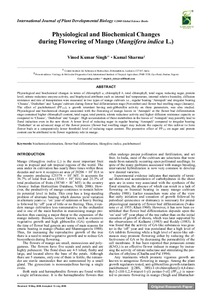| dc.contributor.author | Singh, V. |
| dc.contributor.author | Sharma, K. |
| dc.date.accessioned | 2019-12-04T11:19:21Z |
| dc.date.available | 2019-12-04T11:19:21Z |
| dc.date.issued | 2008 |
| dc.identifier.citation | Singh, V. & Sharma, K. (2008). Physiological and biochemical changes during flowering of Mango (Mangifera indica L.). International Journal of Plant Developmental Biology, 2(2), 100-105. |
| dc.identifier.issn | 1749- 4753 |
| dc.identifier.uri | https://hdl.handle.net/20.500.12478/3449 |
| dc.description.abstract | Physiological and biochemical changes in terms of chlorophyll a , chlorophyll b , total chlorophyll, total sugar, reducing sugar, protein level, nitrate reductase enzyme activity, and biophysical attributes such as internal leaf temperature, internal relative humidity, diffusion resistance and rate of transpiration were measured in two types of mango cultivars i.e., regular bearing ‘Amrapali’ and irregular bearing ‘Chausa’, ‘Dashehari’ and ‘Langra’ cultivars during flower bud differentiation stage (November) and flower bud swelling stage (January). The effect of paclobutrazol (PP333), a growth retardant having anti-gibberellin activity on these parameters, was also studied. Physiological and biochemical changes associated with the flowering of mango leaves in ‘Amrapali’ at the flower bud differentiation stage contained higher chlorophyll content, total sugar, total protein, nitrate reductase activity and higher diffusion resistance capacity as compared to ‘Chausa’, ‘Dashehari’ and ‘Langra’. High accumulation of these metabolites in the leaves of ‘Amrapali’ may possibly lead to floral induction even in the new shoot. A lower level of reducing sugar in regular bearing ‘Amrapali’ compared to irregular bearing ‘Dashehari’ at an advanced stage of the flower process (flower bud swelling stage) may indicate the capacity of this cultivar to form flower buds at a comparatively lower threshold level of reducing sugar content. The promotive effect of PP333 on sugar and protein content can be attributed to its flower regulatory role in mango. |
| dc.language.iso | en |
| dc.subject | Biochemical Estimation |
| dc.subject | Flower Bud Differentiation |
| dc.subject | Mangifera Indica |
| dc.subject | Paclobutrazol |
| dc.subject | Chlorophyll |
| dc.subject | Physiological And Biochemical Changes |
| dc.subject | Nitrate Reductase |
| dc.subject | Proteins |
| dc.title | Physiological and biochemical changes during flowering of Mango (Mangifera indica L.) |
| dc.type | Journal Article |
| dc.description.version | Peer Review |
| cg.contributor.affiliation | Central Institute for Subtropical Horticulture, India |
| cg.contributor.affiliation | International Institute of Tropical Agriculture |
| cg.coverage.region | Asia |
| cg.coverage.region | Africa |
| cg.coverage.region | Southeast Asia |
| cg.coverage.region | West Africa |
| cg.coverage.country | India |
| cg.coverage.country | Nigeria |
| cg.authorship.types | CGIAR and advanced research institute |
| cg.iitasubject | Agribusiness |
| cg.iitasubject | Livelihoods |
| cg.iitasubject | Handling, Transport, Storage And Protection Of Agricultural Products |
| cg.iitasubject | Farm Management |
| cg.iitasubject | Nutrition |
| cg.iitasubject | Domestic Trade |
| cg.iitasubject | Markets |
| cg.iitasubject | Food Security |
| cg.accessibilitystatus | Limited Access |
| local.dspaceid | 95420 |

